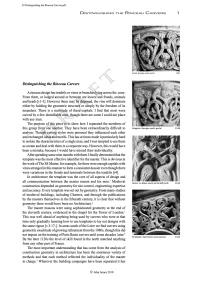Amiens, Notre-Dame
documents

Building Data for Amiens, Notre-Dame
- Type: Cathedral
- Affiliation:
- Region: Picardie
- Department: Somme
- Coords: 49.894, 2.3020
- Surveyed: 1972-74, 1977, 1980-83, 2003, 2011, 2015, 2017
Documents for Amiens, Notre-Dame
1211/22Work begun by bishop Evrard, from 1236 document by Geoffrey d'Eu QUOEDAM ASSUMUNTUR LOCA AD FABRICAM ECCLESIAE CATHEDRALIS ...NAM SI PECCATIS NOSTRIS EXIGENTIBUS, PERMISERIT DOMINUS NOSTRAM ECCLESIAM CONCREMARI , AD NOSTRUM PROFECTUM HOC EVENISSE CREDAMUS, CONSIDERANTES ALTITUDINEM DIVINI CONSILII SUPER SALUTEM GENERIS HUMANI. QUONIAM PER CLARAE MEMORIAE EPISCOPUM EVERARDUM FUERAT ORDINATUM ACCEDENTE CONSENSU AMBIANENSIS CLERI ET POPULI, TANQUAM EIS SUISSET A DOMINO INSPIRATUM QUATENUS FUNDAMENTA ECCLESIE AMPLIARET... "Certain places are acquired for the construction of the cathedral church" ...For if because of our sins the Lord allowed our church to be consumed by fire let us believe this happened for our profit, considering the loftiness of divine counsel for the well-being of the human race. Since it had been prescribed by Bishop Evrard, of shining memory, with the consent of the clergy and people of Amiens, inspired by God, that he should enlarge the foundations of the church... Source: Gallia Christiana, Paris, 1751, x, Instrumenta, cols. 342-343. Translation from Murray, Stephen, Notre-Dame, Cathedral of Amiens, pg. 136. |
1220Inscription in the labyrinth Memore quant leuvre de leglise de cheens fu commenchie. Et si comme il est escript el moilon de le maison dedalus. En lan de grace mil. IIc. & XX. fu leuvre de cheens premierement encommenchie. Adonc yert de cheste evesquie evrart evesques benis. et roy de france loys qui fu filz phelippe le sage. chil qui maistre yert de loeuvre maistre robert estoit nommes et de lusarches surnommes. maistre thomas fu apres luy de cormont et apres ses filz maistre regnault qui mestre fist a chest point chy ceste lestre que lincarnation valoit .XIIIc. ans. XII. en faloit. Note on when this church was begun. Just as it is written in the slab of the House of Daedalus. In the year of grace 1220 was this work first began. At that time the bishop of this diocese was Evrard blessed bishop. And the king of France was Louis who was the son of Philip the wise. He who was master of the work was named Master Robert and surnamed de Luzarches. Master Thomas de Cormont was after him and afterwords his son Master Renaud who had this inscription placed at this place in the year of incarnation 1288. Source: Archives de la Somme, Amiens, Chapitre d'Amiens, reg. aux distrib., ii, Martyrology, fol. 247r The labyrinth was destroyed in 1827. Brandenberg, "La façade…", 259, suggests the inscription is not trustworthy because of errors in the latter part. However, it does refer to Bishop Evrard de Fouilly who was bishop 1211 to 1222. |
1220 and afterCharter of 1241 refers to a fire in bishop Evrard's time, and subsequent enlargement of cathedral ...QUOD CUM ECCLESIAM AMBIANENSEM, TEMPORE PII RECORDATIONIS EVERARDI EPISCOPI AMBIANENSIS, TUNC EIDEM ECCLESIE PRESIDENTIS, CONTIGISSET INCENDIO CORRUISSE, PER EUNDEM EVERARDUM, EPISCOPUM, ACCEDENTE CONSENSU CLERI ET POPULI AMBIANENSIS, FUERAT ORDINATUM, ET ERAT NECESSE QUATINUS FUNDAMENTUM DICTE ECCLESIE AMPLIARET, AD QUAS AMPLAITIONED ECCLESIAM BTE. FIRMINI CONFESSORIS RETRO SITAM CEDERE OPORTEBAT. ...that the church of Amiens was burned in the time of Evrard of pious memory, bishop of Amiens, then presiding over the church; it was ordained by the same bishop Evrard, with the consent of the clergy and people of Amiens, and it was necessary that the foundation of said church should be enlarged, for which enlargement it was appropriate that the church of Saint-Firmin the Confessor, situated in the rear, should yield its site. Source: Archives de la Somme, Amiens, G 672: Cartulaire du Chapitre, i, No.316, 362. Charter refers to the commencement of the cathedral after a fire, under direction of Evrard. Gallia Christiana, x, 1182 accepts this date, but no reason given. The document could be read to suggest that some work may have started earlier, as te foundations are described as being "enlarged", but this may simply refer to an enlargement over that church which had been destroyed. |
1233Rules concerning the use of the choir: Dean able to control access to the choir ITEM, SI INORDINATE SE HABEANT INGRESSI CHORUM, DECANUS POTEST EOS EJICERE A CHORO SICUT ALIOS QUI CHORUM INGREDIUNTUR. Also, if someone has entered the choir inappropriately, the dean may eject them or anyone else who has entered the choir inappropriately. Source: Archives de la Somme, Amiens, G 672: Cartulaire du Chapitre, i, No. 232, 281-283. |
1236Charter permitting the destruction of the parish church of Saint-Firmin. ...QUATENUS FUNDAMENTA ECCLESIAE AMPLIARET ET MUNDARET SANCTA UT CUSTOS VASORUM, AD QUAM AMPLIATIONEM ET MUNDATIONEM FACIENDAM DE COMMUNI CONSILIO OPORTEBAT ECCLESIAM BEATI FIRMINI CONFESSORIS MATRICIS SUAE CEDERE FUNDAMENTIS; ET QUIA ECCLESIA ILLA PAROCHIANIS SUIS ERAT INVIA ET OCCULTA, ET HOSPITALARIA DOMUS PERICULOSE SEDEBAT AD TOTIUS URBIS, SICUT VISUM EST, DETRIMENTUM, PRAEDICTAE ORDINATIONI FUIT ADJECTUM, QUOD ECCLESIA BEATI FIRMINI AD DOMUM HOSPITALARIAM, ET HOSPITALARIA APUD MAGNUM PONTEM... ...that he should enlarge the foundations of the church, and as guardian of the vessels, cleanse the sanctuary, for this enlargement and cleaning it was appropriate, with common counsel, for the church of the blessed Firmin the Confessor to yield to the foundations of its mother church and because that church was inaccessible and out-of-the-way for its parishioners, and [because] the hospital house was in a dangerous place, to the detriment, it seemed, of the entire city, it was added to the aforementioned ordinance that the church of the blessed Firmin should be transferred to the [site of the] hospital, and the hospital to near the great bridge... Source: GC, 1751, x, Instrumenta, col. 342. Translation from Murray, 1996, 136. Charter of Geoffroi d’Eu dated 31 March permitting the destruction of the parish church of St. Firmin the Confessor, but work was delayed until 1238. By tradition this church stood where the north transept now is. |









